An Analysis of Starbucks Singapore Supply Chain Management
VerifiedAdded on 2022/12/28
|18
|4409
|1
Report
AI Summary
This report provides a comprehensive analysis of Starbucks Singapore's supply chain management, examining its strategies and challenges in inventory management, reverse logistics, and transportation. It begins with an overview of Starbucks' goals and the challenges it faces, such as climate change impacts on coffee sourcing. The report then delves into key areas of the supply chain, including the use of push and pull strategies for inventory, reverse logistics practices involving partnerships with organizations like Feeding America, and the distribution network. A literature review explores relevant SCM theories, such as game theory and just-in-time methods for inventory management, control management strategies for reverse logistics, and benchmarking/carrier alliances for transportation. The report proposes models for improving the current practices, particularly focusing on addressing weaknesses like high safety stock costs and food wastage, and suggests strategies for enhanced efficiency and cost reduction. The analysis highlights the company's current strategies and their shortcomings and recommends improvements in inventory management, reverse logistics, and transportation, to overcome these challenges and improve the efficiency of the supply chain.
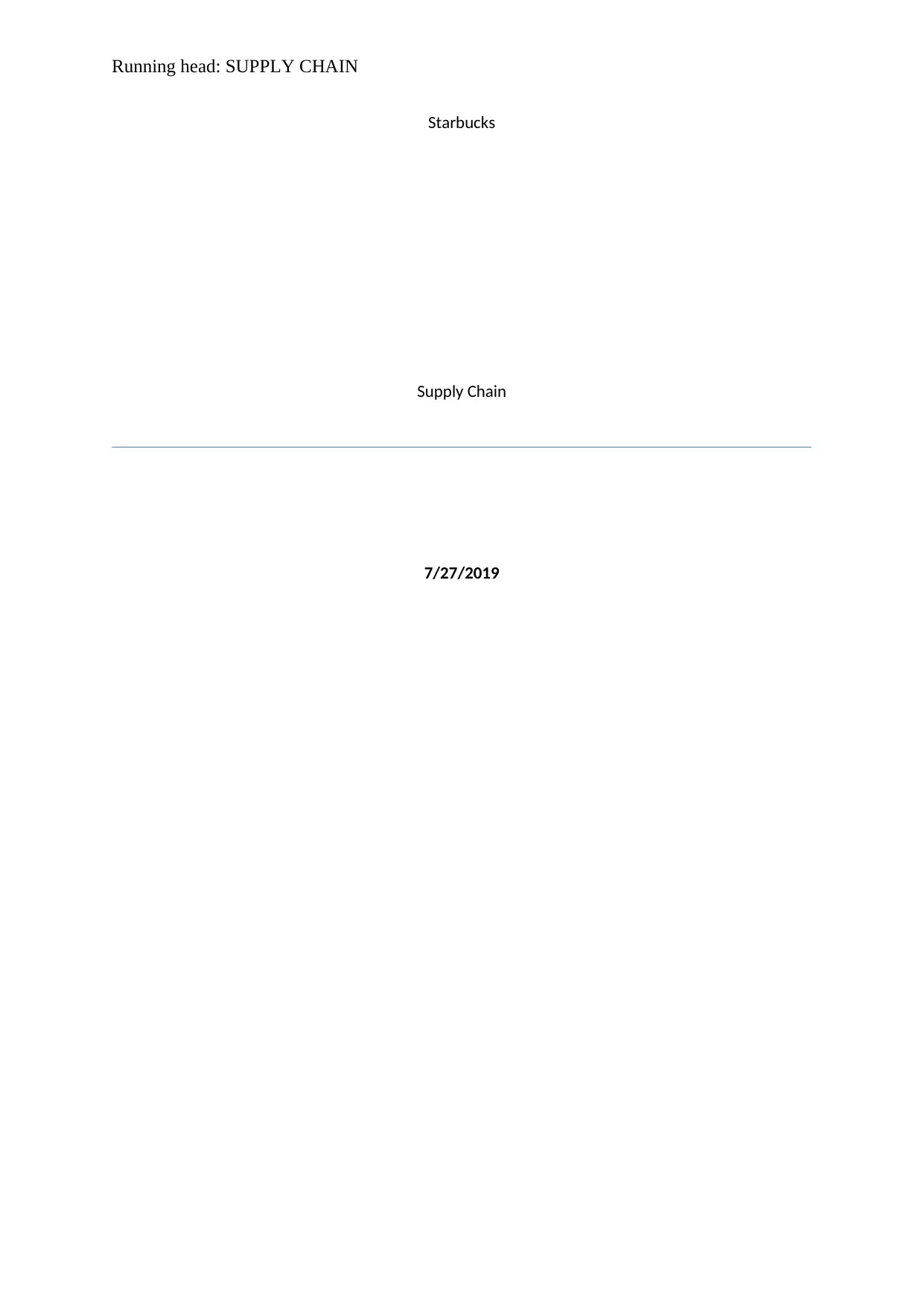
Running head: SUPPLY CHAIN
Starbucks
Supply Chain
7/27/2019
Starbucks
Supply Chain
7/27/2019
Paraphrase This Document
Need a fresh take? Get an instant paraphrase of this document with our AI Paraphraser
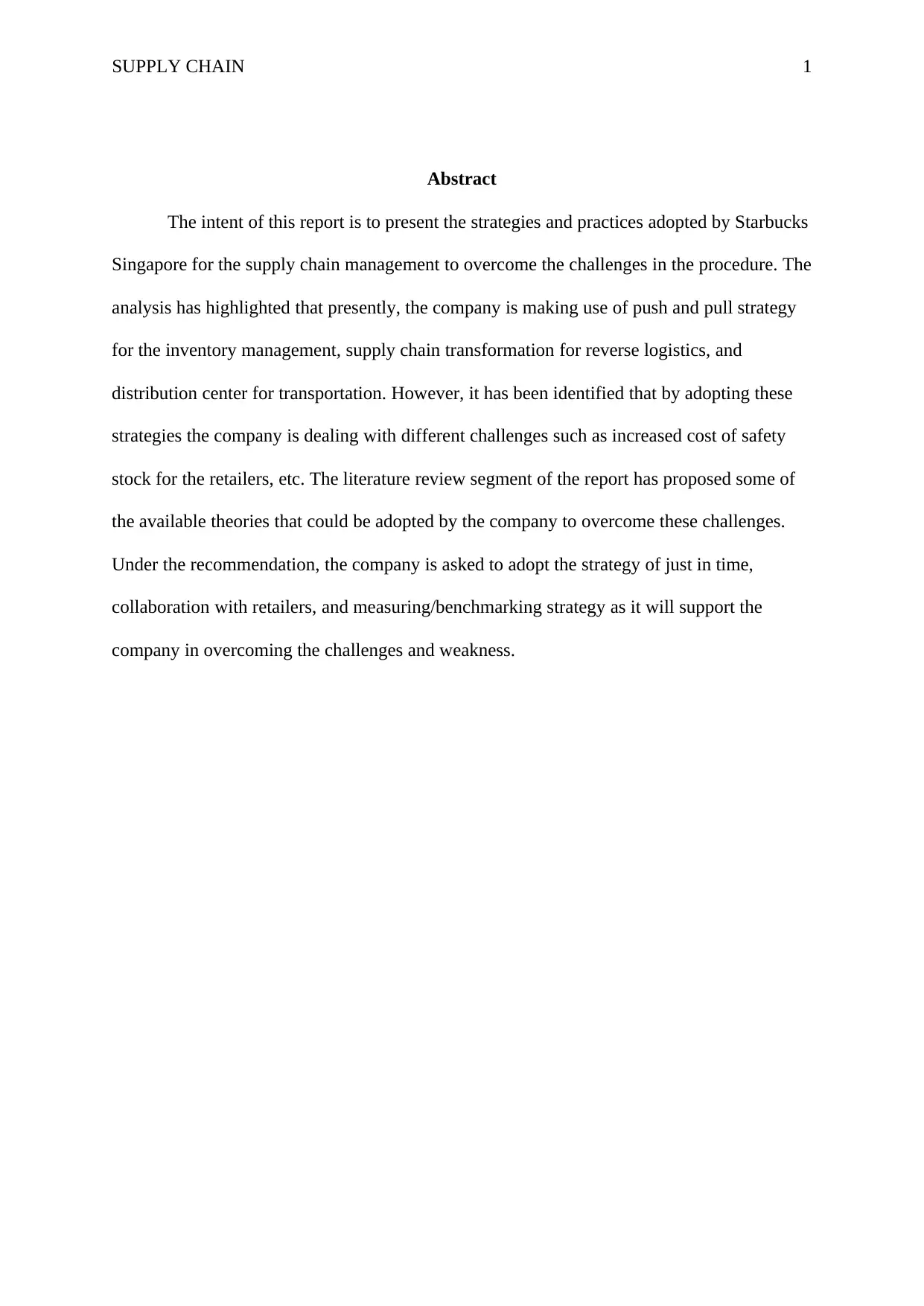
SUPPLY CHAIN 1
Abstract
The intent of this report is to present the strategies and practices adopted by Starbucks
Singapore for the supply chain management to overcome the challenges in the procedure. The
analysis has highlighted that presently, the company is making use of push and pull strategy
for the inventory management, supply chain transformation for reverse logistics, and
distribution center for transportation. However, it has been identified that by adopting these
strategies the company is dealing with different challenges such as increased cost of safety
stock for the retailers, etc. The literature review segment of the report has proposed some of
the available theories that could be adopted by the company to overcome these challenges.
Under the recommendation, the company is asked to adopt the strategy of just in time,
collaboration with retailers, and measuring/benchmarking strategy as it will support the
company in overcoming the challenges and weakness.
Abstract
The intent of this report is to present the strategies and practices adopted by Starbucks
Singapore for the supply chain management to overcome the challenges in the procedure. The
analysis has highlighted that presently, the company is making use of push and pull strategy
for the inventory management, supply chain transformation for reverse logistics, and
distribution center for transportation. However, it has been identified that by adopting these
strategies the company is dealing with different challenges such as increased cost of safety
stock for the retailers, etc. The literature review segment of the report has proposed some of
the available theories that could be adopted by the company to overcome these challenges.
Under the recommendation, the company is asked to adopt the strategy of just in time,
collaboration with retailers, and measuring/benchmarking strategy as it will support the
company in overcoming the challenges and weakness.
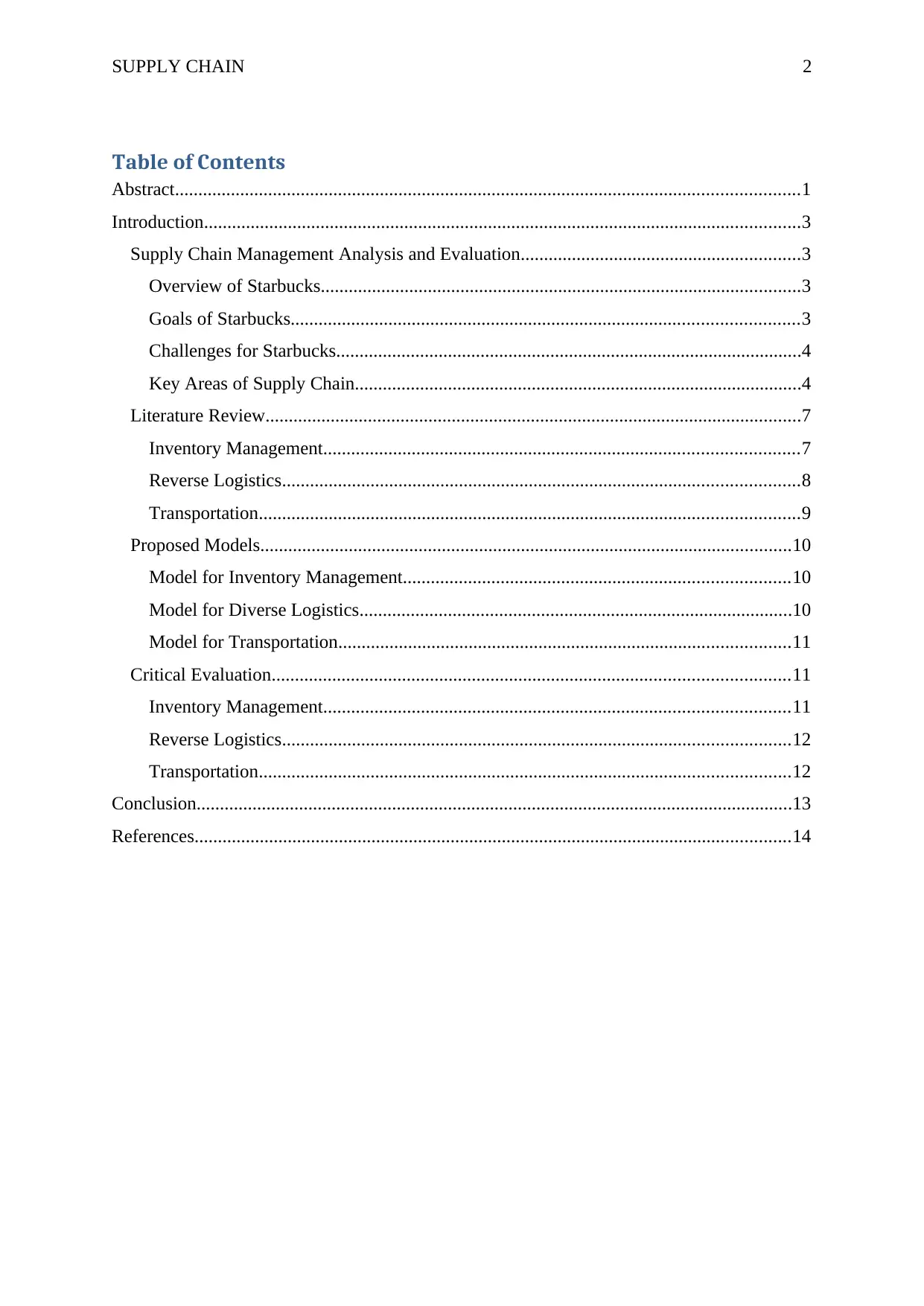
SUPPLY CHAIN 2
Table of Contents
Abstract......................................................................................................................................1
Introduction................................................................................................................................3
Supply Chain Management Analysis and Evaluation............................................................3
Overview of Starbucks.......................................................................................................3
Goals of Starbucks.............................................................................................................3
Challenges for Starbucks....................................................................................................4
Key Areas of Supply Chain................................................................................................4
Literature Review...................................................................................................................7
Inventory Management......................................................................................................7
Reverse Logistics...............................................................................................................8
Transportation....................................................................................................................9
Proposed Models..................................................................................................................10
Model for Inventory Management...................................................................................10
Model for Diverse Logistics.............................................................................................10
Model for Transportation.................................................................................................11
Critical Evaluation...............................................................................................................11
Inventory Management....................................................................................................11
Reverse Logistics.............................................................................................................12
Transportation..................................................................................................................12
Conclusion................................................................................................................................13
References................................................................................................................................14
Table of Contents
Abstract......................................................................................................................................1
Introduction................................................................................................................................3
Supply Chain Management Analysis and Evaluation............................................................3
Overview of Starbucks.......................................................................................................3
Goals of Starbucks.............................................................................................................3
Challenges for Starbucks....................................................................................................4
Key Areas of Supply Chain................................................................................................4
Literature Review...................................................................................................................7
Inventory Management......................................................................................................7
Reverse Logistics...............................................................................................................8
Transportation....................................................................................................................9
Proposed Models..................................................................................................................10
Model for Inventory Management...................................................................................10
Model for Diverse Logistics.............................................................................................10
Model for Transportation.................................................................................................11
Critical Evaluation...............................................................................................................11
Inventory Management....................................................................................................11
Reverse Logistics.............................................................................................................12
Transportation..................................................................................................................12
Conclusion................................................................................................................................13
References................................................................................................................................14
⊘ This is a preview!⊘
Do you want full access?
Subscribe today to unlock all pages.

Trusted by 1+ million students worldwide
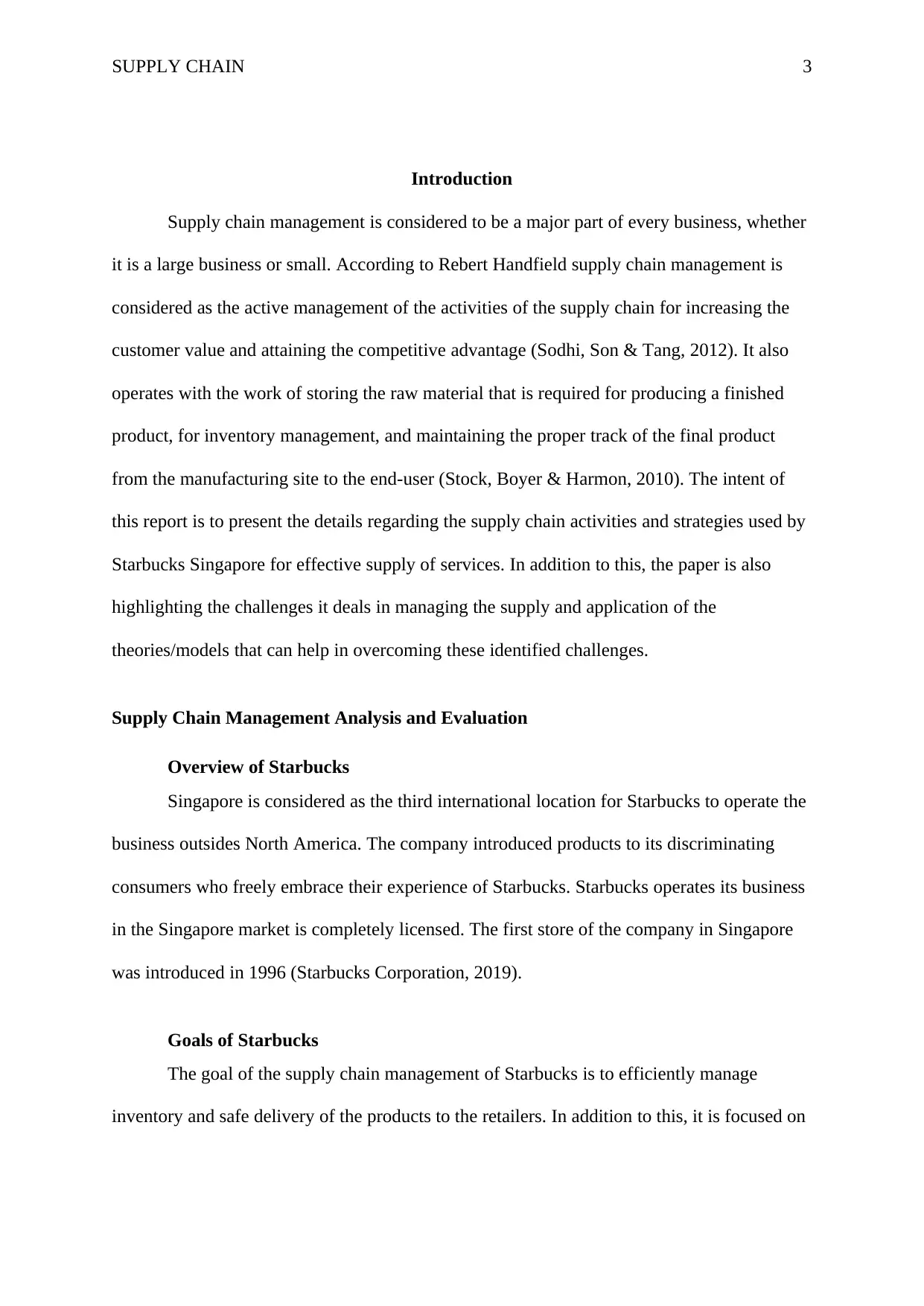
SUPPLY CHAIN 3
Introduction
Supply chain management is considered to be a major part of every business, whether
it is a large business or small. According to Rebert Handfield supply chain management is
considered as the active management of the activities of the supply chain for increasing the
customer value and attaining the competitive advantage (Sodhi, Son & Tang, 2012). It also
operates with the work of storing the raw material that is required for producing a finished
product, for inventory management, and maintaining the proper track of the final product
from the manufacturing site to the end-user (Stock, Boyer & Harmon, 2010). The intent of
this report is to present the details regarding the supply chain activities and strategies used by
Starbucks Singapore for effective supply of services. In addition to this, the paper is also
highlighting the challenges it deals in managing the supply and application of the
theories/models that can help in overcoming these identified challenges.
Supply Chain Management Analysis and Evaluation
Overview of Starbucks
Singapore is considered as the third international location for Starbucks to operate the
business outsides North America. The company introduced products to its discriminating
consumers who freely embrace their experience of Starbucks. Starbucks operates its business
in the Singapore market is completely licensed. The first store of the company in Singapore
was introduced in 1996 (Starbucks Corporation, 2019).
Goals of Starbucks
The goal of the supply chain management of Starbucks is to efficiently manage
inventory and safe delivery of the products to the retailers. In addition to this, it is focused on
Introduction
Supply chain management is considered to be a major part of every business, whether
it is a large business or small. According to Rebert Handfield supply chain management is
considered as the active management of the activities of the supply chain for increasing the
customer value and attaining the competitive advantage (Sodhi, Son & Tang, 2012). It also
operates with the work of storing the raw material that is required for producing a finished
product, for inventory management, and maintaining the proper track of the final product
from the manufacturing site to the end-user (Stock, Boyer & Harmon, 2010). The intent of
this report is to present the details regarding the supply chain activities and strategies used by
Starbucks Singapore for effective supply of services. In addition to this, the paper is also
highlighting the challenges it deals in managing the supply and application of the
theories/models that can help in overcoming these identified challenges.
Supply Chain Management Analysis and Evaluation
Overview of Starbucks
Singapore is considered as the third international location for Starbucks to operate the
business outsides North America. The company introduced products to its discriminating
consumers who freely embrace their experience of Starbucks. Starbucks operates its business
in the Singapore market is completely licensed. The first store of the company in Singapore
was introduced in 1996 (Starbucks Corporation, 2019).
Goals of Starbucks
The goal of the supply chain management of Starbucks is to efficiently manage
inventory and safe delivery of the products to the retailers. In addition to this, it is focused on
Paraphrase This Document
Need a fresh take? Get an instant paraphrase of this document with our AI Paraphraser
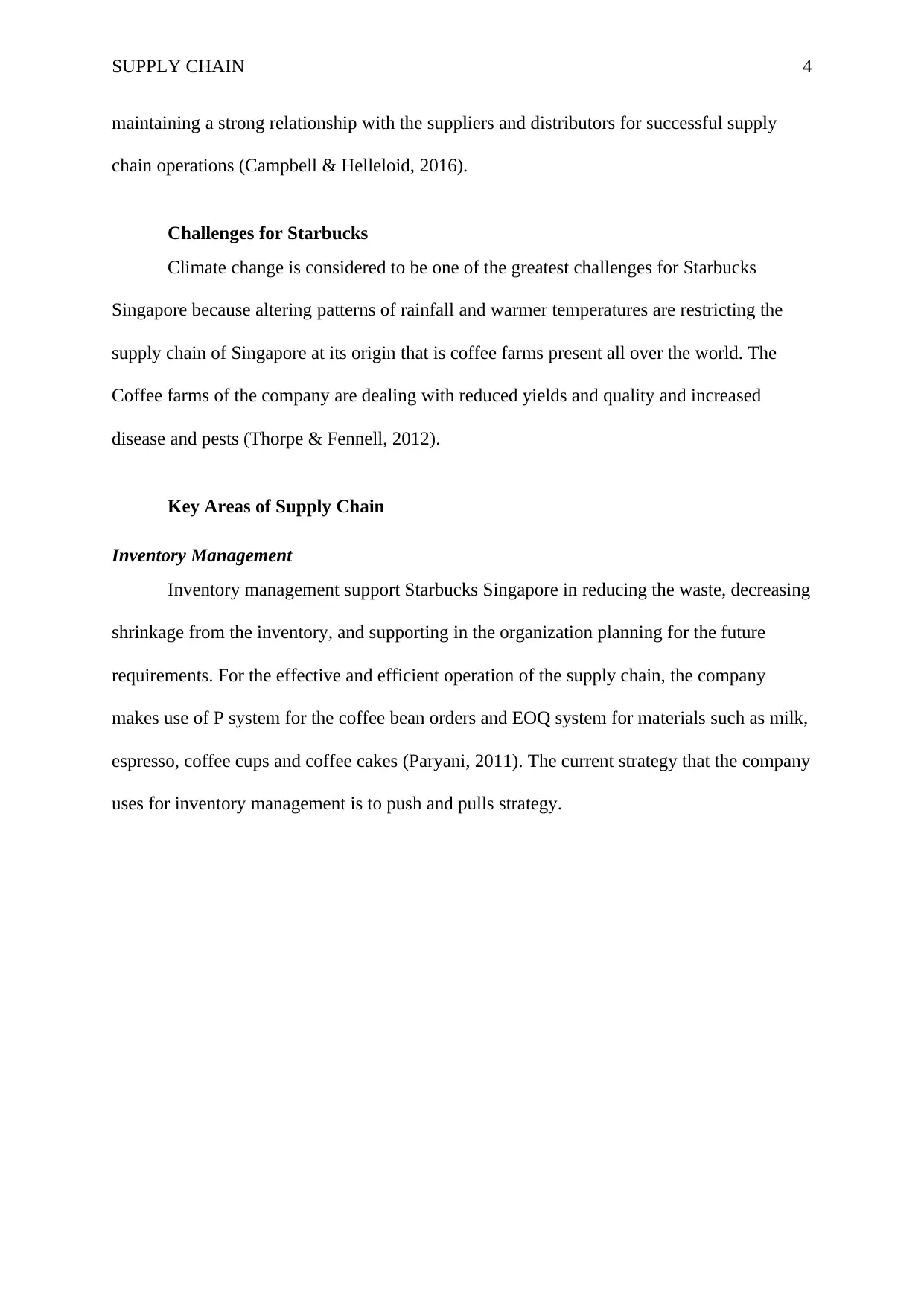
SUPPLY CHAIN 4
maintaining a strong relationship with the suppliers and distributors for successful supply
chain operations (Campbell & Helleloid, 2016).
Challenges for Starbucks
Climate change is considered to be one of the greatest challenges for Starbucks
Singapore because altering patterns of rainfall and warmer temperatures are restricting the
supply chain of Singapore at its origin that is coffee farms present all over the world. The
Coffee farms of the company are dealing with reduced yields and quality and increased
disease and pests (Thorpe & Fennell, 2012).
Key Areas of Supply Chain
Inventory Management
Inventory management support Starbucks Singapore in reducing the waste, decreasing
shrinkage from the inventory, and supporting in the organization planning for the future
requirements. For the effective and efficient operation of the supply chain, the company
makes use of P system for the coffee bean orders and EOQ system for materials such as milk,
espresso, coffee cups and coffee cakes (Paryani, 2011). The current strategy that the company
uses for inventory management is to push and pulls strategy.
maintaining a strong relationship with the suppliers and distributors for successful supply
chain operations (Campbell & Helleloid, 2016).
Challenges for Starbucks
Climate change is considered to be one of the greatest challenges for Starbucks
Singapore because altering patterns of rainfall and warmer temperatures are restricting the
supply chain of Singapore at its origin that is coffee farms present all over the world. The
Coffee farms of the company are dealing with reduced yields and quality and increased
disease and pests (Thorpe & Fennell, 2012).
Key Areas of Supply Chain
Inventory Management
Inventory management support Starbucks Singapore in reducing the waste, decreasing
shrinkage from the inventory, and supporting in the organization planning for the future
requirements. For the effective and efficient operation of the supply chain, the company
makes use of P system for the coffee bean orders and EOQ system for materials such as milk,
espresso, coffee cups and coffee cakes (Paryani, 2011). The current strategy that the company
uses for inventory management is to push and pulls strategy.
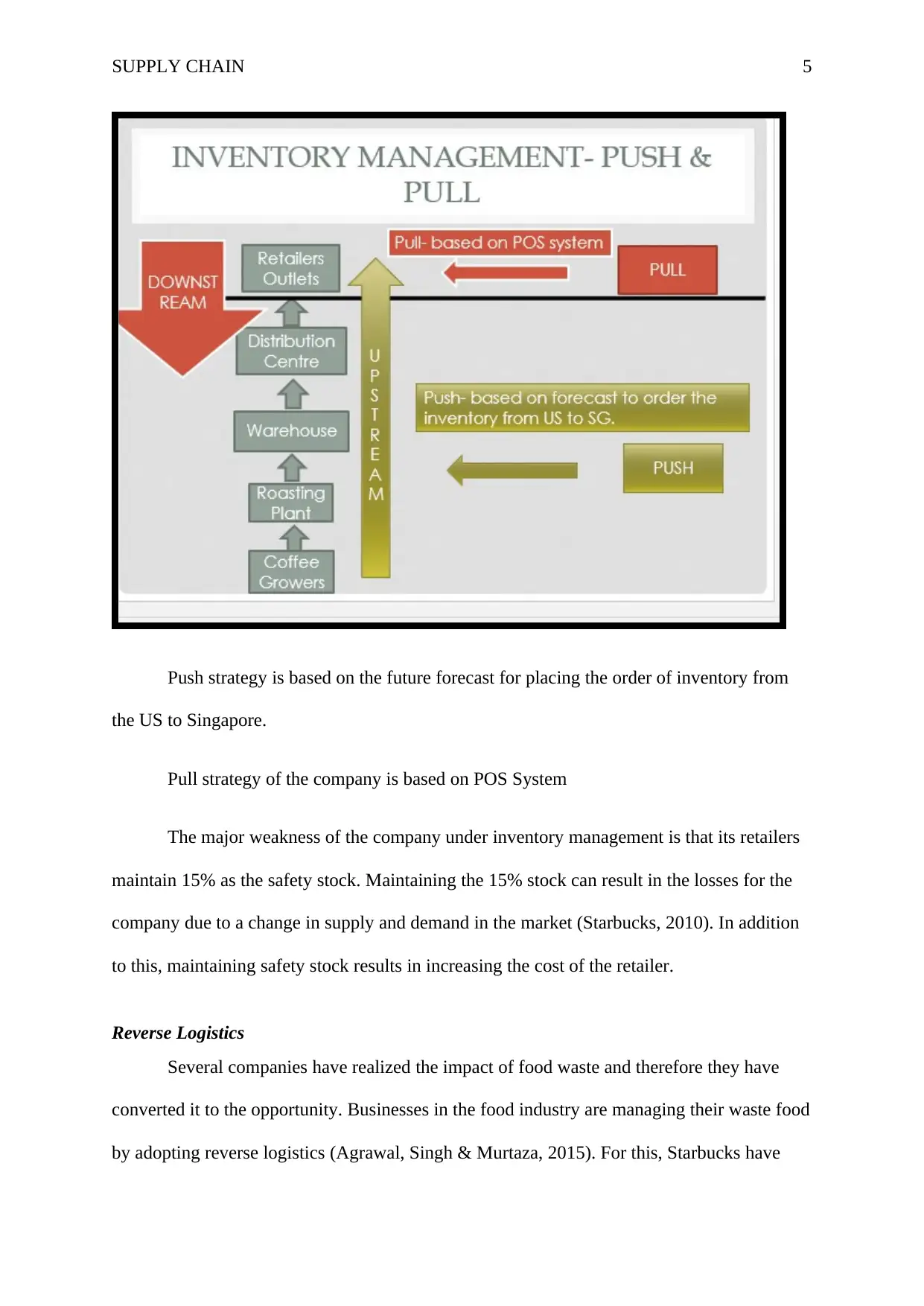
SUPPLY CHAIN 5
Push strategy is based on the future forecast for placing the order of inventory from
the US to Singapore.
Pull strategy of the company is based on POS System
The major weakness of the company under inventory management is that its retailers
maintain 15% as the safety stock. Maintaining the 15% stock can result in the losses for the
company due to a change in supply and demand in the market (Starbucks, 2010). In addition
to this, maintaining safety stock results in increasing the cost of the retailer.
Reverse Logistics
Several companies have realized the impact of food waste and therefore they have
converted it to the opportunity. Businesses in the food industry are managing their waste food
by adopting reverse logistics (Agrawal, Singh & Murtaza, 2015). For this, Starbucks have
Push strategy is based on the future forecast for placing the order of inventory from
the US to Singapore.
Pull strategy of the company is based on POS System
The major weakness of the company under inventory management is that its retailers
maintain 15% as the safety stock. Maintaining the 15% stock can result in the losses for the
company due to a change in supply and demand in the market (Starbucks, 2010). In addition
to this, maintaining safety stock results in increasing the cost of the retailer.
Reverse Logistics
Several companies have realized the impact of food waste and therefore they have
converted it to the opportunity. Businesses in the food industry are managing their waste food
by adopting reverse logistics (Agrawal, Singh & Murtaza, 2015). For this, Starbucks have
⊘ This is a preview!⊘
Do you want full access?
Subscribe today to unlock all pages.

Trusted by 1+ million students worldwide
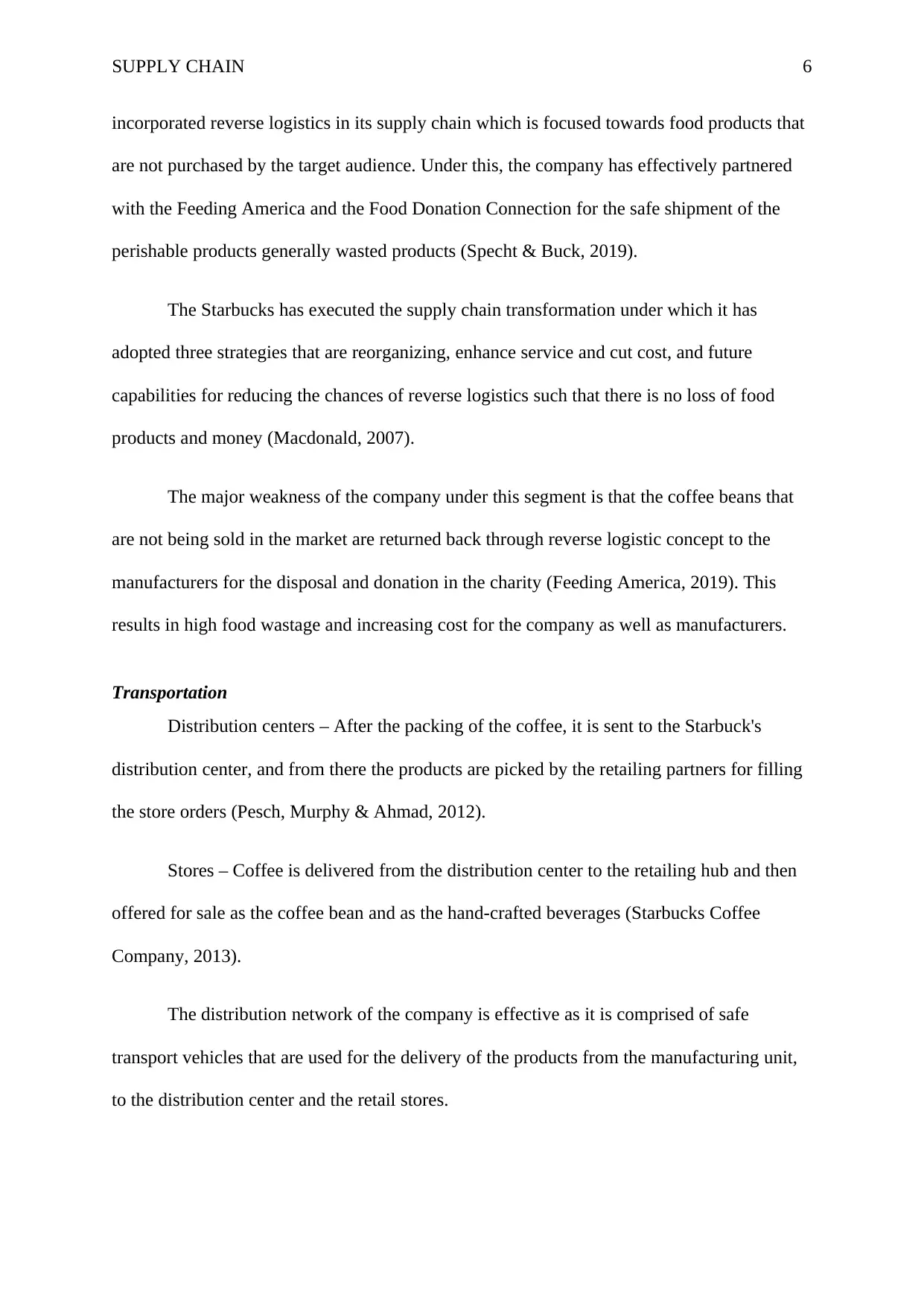
SUPPLY CHAIN 6
incorporated reverse logistics in its supply chain which is focused towards food products that
are not purchased by the target audience. Under this, the company has effectively partnered
with the Feeding America and the Food Donation Connection for the safe shipment of the
perishable products generally wasted products (Specht & Buck, 2019).
The Starbucks has executed the supply chain transformation under which it has
adopted three strategies that are reorganizing, enhance service and cut cost, and future
capabilities for reducing the chances of reverse logistics such that there is no loss of food
products and money (Macdonald, 2007).
The major weakness of the company under this segment is that the coffee beans that
are not being sold in the market are returned back through reverse logistic concept to the
manufacturers for the disposal and donation in the charity (Feeding America, 2019). This
results in high food wastage and increasing cost for the company as well as manufacturers.
Transportation
Distribution centers – After the packing of the coffee, it is sent to the Starbuck's
distribution center, and from there the products are picked by the retailing partners for filling
the store orders (Pesch, Murphy & Ahmad, 2012).
Stores – Coffee is delivered from the distribution center to the retailing hub and then
offered for sale as the coffee bean and as the hand-crafted beverages (Starbucks Coffee
Company, 2013).
The distribution network of the company is effective as it is comprised of safe
transport vehicles that are used for the delivery of the products from the manufacturing unit,
to the distribution center and the retail stores.
incorporated reverse logistics in its supply chain which is focused towards food products that
are not purchased by the target audience. Under this, the company has effectively partnered
with the Feeding America and the Food Donation Connection for the safe shipment of the
perishable products generally wasted products (Specht & Buck, 2019).
The Starbucks has executed the supply chain transformation under which it has
adopted three strategies that are reorganizing, enhance service and cut cost, and future
capabilities for reducing the chances of reverse logistics such that there is no loss of food
products and money (Macdonald, 2007).
The major weakness of the company under this segment is that the coffee beans that
are not being sold in the market are returned back through reverse logistic concept to the
manufacturers for the disposal and donation in the charity (Feeding America, 2019). This
results in high food wastage and increasing cost for the company as well as manufacturers.
Transportation
Distribution centers – After the packing of the coffee, it is sent to the Starbuck's
distribution center, and from there the products are picked by the retailing partners for filling
the store orders (Pesch, Murphy & Ahmad, 2012).
Stores – Coffee is delivered from the distribution center to the retailing hub and then
offered for sale as the coffee bean and as the hand-crafted beverages (Starbucks Coffee
Company, 2013).
The distribution network of the company is effective as it is comprised of safe
transport vehicles that are used for the delivery of the products from the manufacturing unit,
to the distribution center and the retail stores.
Paraphrase This Document
Need a fresh take? Get an instant paraphrase of this document with our AI Paraphraser
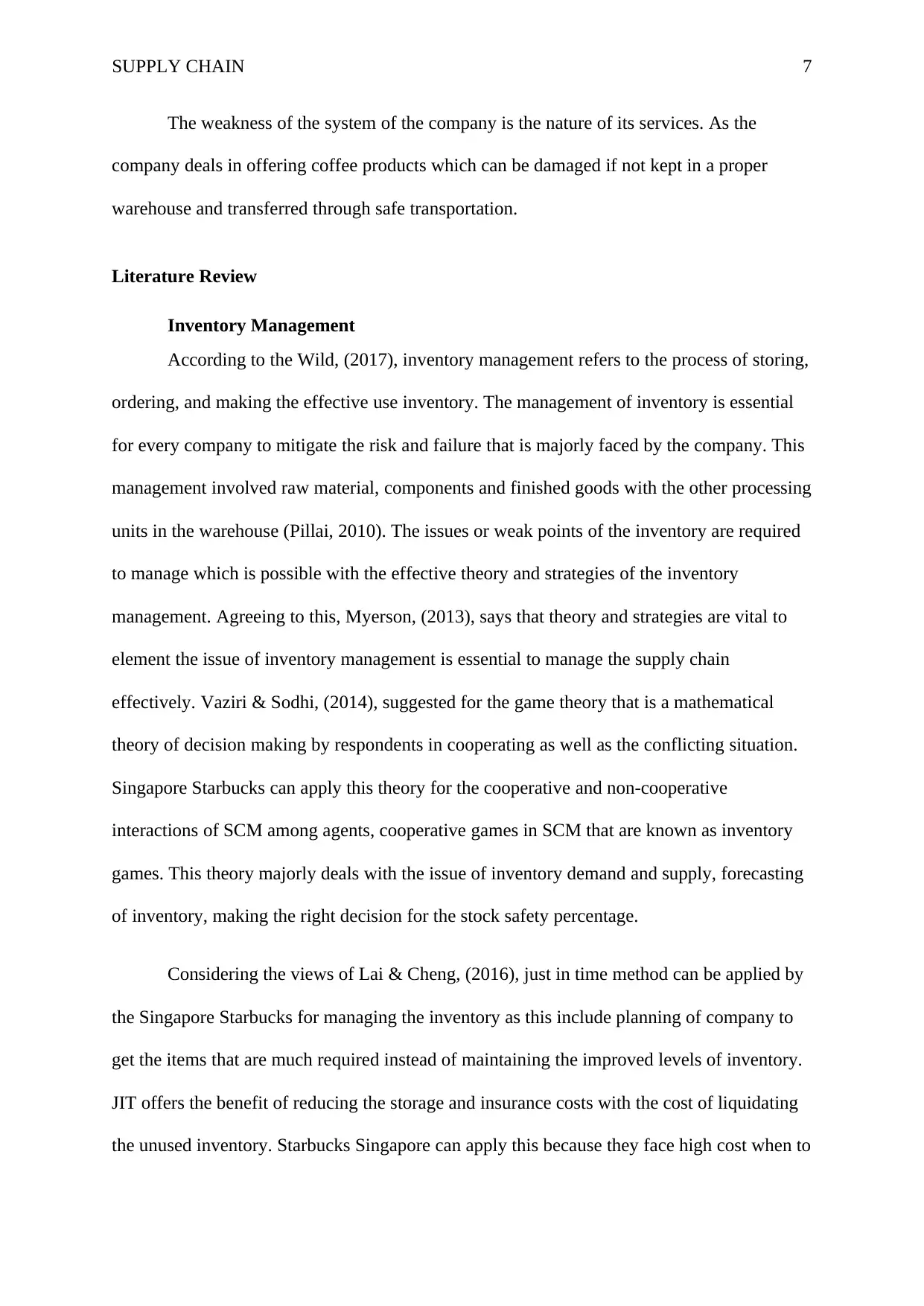
SUPPLY CHAIN 7
The weakness of the system of the company is the nature of its services. As the
company deals in offering coffee products which can be damaged if not kept in a proper
warehouse and transferred through safe transportation.
Literature Review
Inventory Management
According to the Wild, (2017), inventory management refers to the process of storing,
ordering, and making the effective use inventory. The management of inventory is essential
for every company to mitigate the risk and failure that is majorly faced by the company. This
management involved raw material, components and finished goods with the other processing
units in the warehouse (Pillai, 2010). The issues or weak points of the inventory are required
to manage which is possible with the effective theory and strategies of the inventory
management. Agreeing to this, Myerson, (2013), says that theory and strategies are vital to
element the issue of inventory management is essential to manage the supply chain
effectively. Vaziri & Sodhi, (2014), suggested for the game theory that is a mathematical
theory of decision making by respondents in cooperating as well as the conflicting situation.
Singapore Starbucks can apply this theory for the cooperative and non-cooperative
interactions of SCM among agents, cooperative games in SCM that are known as inventory
games. This theory majorly deals with the issue of inventory demand and supply, forecasting
of inventory, making the right decision for the stock safety percentage.
Considering the views of Lai & Cheng, (2016), just in time method can be applied by
the Singapore Starbucks for managing the inventory as this include planning of company to
get the items that are much required instead of maintaining the improved levels of inventory.
JIT offers the benefit of reducing the storage and insurance costs with the cost of liquidating
the unused inventory. Starbucks Singapore can apply this because they face high cost when to
The weakness of the system of the company is the nature of its services. As the
company deals in offering coffee products which can be damaged if not kept in a proper
warehouse and transferred through safe transportation.
Literature Review
Inventory Management
According to the Wild, (2017), inventory management refers to the process of storing,
ordering, and making the effective use inventory. The management of inventory is essential
for every company to mitigate the risk and failure that is majorly faced by the company. This
management involved raw material, components and finished goods with the other processing
units in the warehouse (Pillai, 2010). The issues or weak points of the inventory are required
to manage which is possible with the effective theory and strategies of the inventory
management. Agreeing to this, Myerson, (2013), says that theory and strategies are vital to
element the issue of inventory management is essential to manage the supply chain
effectively. Vaziri & Sodhi, (2014), suggested for the game theory that is a mathematical
theory of decision making by respondents in cooperating as well as the conflicting situation.
Singapore Starbucks can apply this theory for the cooperative and non-cooperative
interactions of SCM among agents, cooperative games in SCM that are known as inventory
games. This theory majorly deals with the issue of inventory demand and supply, forecasting
of inventory, making the right decision for the stock safety percentage.
Considering the views of Lai & Cheng, (2016), just in time method can be applied by
the Singapore Starbucks for managing the inventory as this include planning of company to
get the items that are much required instead of maintaining the improved levels of inventory.
JIT offers the benefit of reducing the storage and insurance costs with the cost of liquidating
the unused inventory. Starbucks Singapore can apply this because they face high cost when to
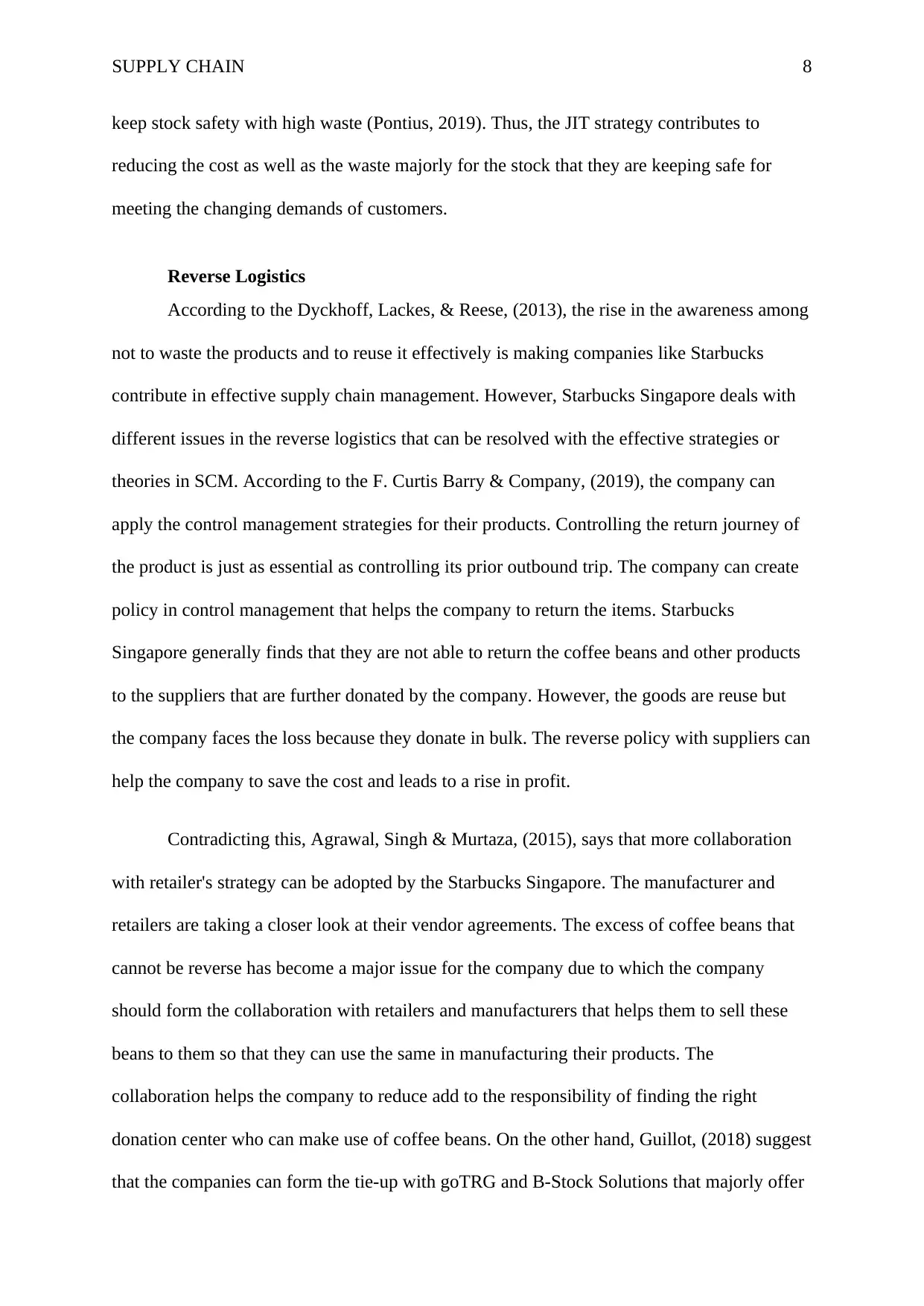
SUPPLY CHAIN 8
keep stock safety with high waste (Pontius, 2019). Thus, the JIT strategy contributes to
reducing the cost as well as the waste majorly for the stock that they are keeping safe for
meeting the changing demands of customers.
Reverse Logistics
According to the Dyckhoff, Lackes, & Reese, (2013), the rise in the awareness among
not to waste the products and to reuse it effectively is making companies like Starbucks
contribute in effective supply chain management. However, Starbucks Singapore deals with
different issues in the reverse logistics that can be resolved with the effective strategies or
theories in SCM. According to the F. Curtis Barry & Company, (2019), the company can
apply the control management strategies for their products. Controlling the return journey of
the product is just as essential as controlling its prior outbound trip. The company can create
policy in control management that helps the company to return the items. Starbucks
Singapore generally finds that they are not able to return the coffee beans and other products
to the suppliers that are further donated by the company. However, the goods are reuse but
the company faces the loss because they donate in bulk. The reverse policy with suppliers can
help the company to save the cost and leads to a rise in profit.
Contradicting this, Agrawal, Singh & Murtaza, (2015), says that more collaboration
with retailer's strategy can be adopted by the Starbucks Singapore. The manufacturer and
retailers are taking a closer look at their vendor agreements. The excess of coffee beans that
cannot be reverse has become a major issue for the company due to which the company
should form the collaboration with retailers and manufacturers that helps them to sell these
beans to them so that they can use the same in manufacturing their products. The
collaboration helps the company to reduce add to the responsibility of finding the right
donation center who can make use of coffee beans. On the other hand, Guillot, (2018) suggest
that the companies can form the tie-up with goTRG and B-Stock Solutions that majorly offer
keep stock safety with high waste (Pontius, 2019). Thus, the JIT strategy contributes to
reducing the cost as well as the waste majorly for the stock that they are keeping safe for
meeting the changing demands of customers.
Reverse Logistics
According to the Dyckhoff, Lackes, & Reese, (2013), the rise in the awareness among
not to waste the products and to reuse it effectively is making companies like Starbucks
contribute in effective supply chain management. However, Starbucks Singapore deals with
different issues in the reverse logistics that can be resolved with the effective strategies or
theories in SCM. According to the F. Curtis Barry & Company, (2019), the company can
apply the control management strategies for their products. Controlling the return journey of
the product is just as essential as controlling its prior outbound trip. The company can create
policy in control management that helps the company to return the items. Starbucks
Singapore generally finds that they are not able to return the coffee beans and other products
to the suppliers that are further donated by the company. However, the goods are reuse but
the company faces the loss because they donate in bulk. The reverse policy with suppliers can
help the company to save the cost and leads to a rise in profit.
Contradicting this, Agrawal, Singh & Murtaza, (2015), says that more collaboration
with retailer's strategy can be adopted by the Starbucks Singapore. The manufacturer and
retailers are taking a closer look at their vendor agreements. The excess of coffee beans that
cannot be reverse has become a major issue for the company due to which the company
should form the collaboration with retailers and manufacturers that helps them to sell these
beans to them so that they can use the same in manufacturing their products. The
collaboration helps the company to reduce add to the responsibility of finding the right
donation center who can make use of coffee beans. On the other hand, Guillot, (2018) suggest
that the companies can form the tie-up with goTRG and B-Stock Solutions that majorly offer
⊘ This is a preview!⊘
Do you want full access?
Subscribe today to unlock all pages.

Trusted by 1+ million students worldwide
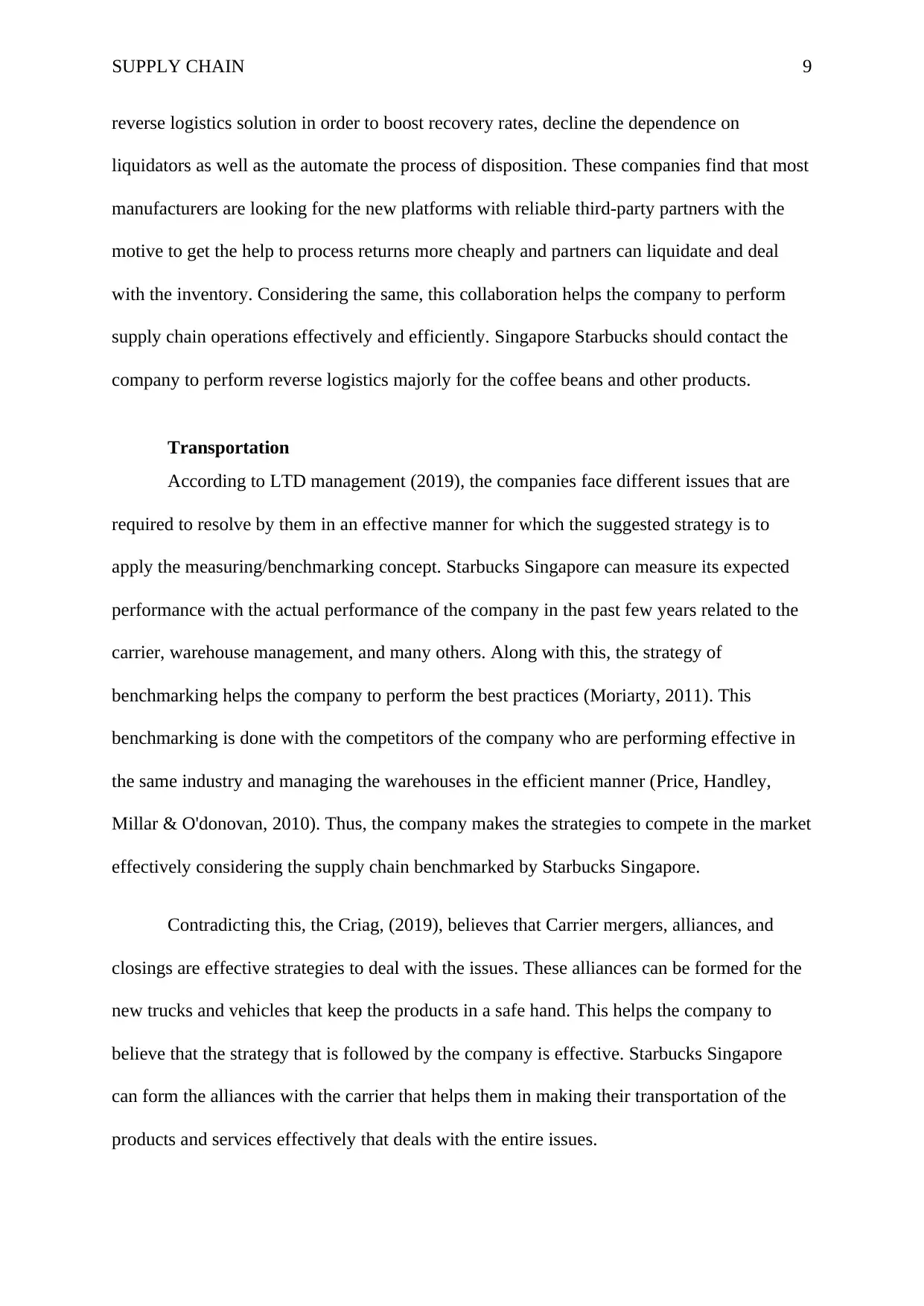
SUPPLY CHAIN 9
reverse logistics solution in order to boost recovery rates, decline the dependence on
liquidators as well as the automate the process of disposition. These companies find that most
manufacturers are looking for the new platforms with reliable third-party partners with the
motive to get the help to process returns more cheaply and partners can liquidate and deal
with the inventory. Considering the same, this collaboration helps the company to perform
supply chain operations effectively and efficiently. Singapore Starbucks should contact the
company to perform reverse logistics majorly for the coffee beans and other products.
Transportation
According to LTD management (2019), the companies face different issues that are
required to resolve by them in an effective manner for which the suggested strategy is to
apply the measuring/benchmarking concept. Starbucks Singapore can measure its expected
performance with the actual performance of the company in the past few years related to the
carrier, warehouse management, and many others. Along with this, the strategy of
benchmarking helps the company to perform the best practices (Moriarty, 2011). This
benchmarking is done with the competitors of the company who are performing effective in
the same industry and managing the warehouses in the efficient manner (Price, Handley,
Millar & O'donovan, 2010). Thus, the company makes the strategies to compete in the market
effectively considering the supply chain benchmarked by Starbucks Singapore.
Contradicting this, the Criag, (2019), believes that Carrier mergers, alliances, and
closings are effective strategies to deal with the issues. These alliances can be formed for the
new trucks and vehicles that keep the products in a safe hand. This helps the company to
believe that the strategy that is followed by the company is effective. Starbucks Singapore
can form the alliances with the carrier that helps them in making their transportation of the
products and services effectively that deals with the entire issues.
reverse logistics solution in order to boost recovery rates, decline the dependence on
liquidators as well as the automate the process of disposition. These companies find that most
manufacturers are looking for the new platforms with reliable third-party partners with the
motive to get the help to process returns more cheaply and partners can liquidate and deal
with the inventory. Considering the same, this collaboration helps the company to perform
supply chain operations effectively and efficiently. Singapore Starbucks should contact the
company to perform reverse logistics majorly for the coffee beans and other products.
Transportation
According to LTD management (2019), the companies face different issues that are
required to resolve by them in an effective manner for which the suggested strategy is to
apply the measuring/benchmarking concept. Starbucks Singapore can measure its expected
performance with the actual performance of the company in the past few years related to the
carrier, warehouse management, and many others. Along with this, the strategy of
benchmarking helps the company to perform the best practices (Moriarty, 2011). This
benchmarking is done with the competitors of the company who are performing effective in
the same industry and managing the warehouses in the efficient manner (Price, Handley,
Millar & O'donovan, 2010). Thus, the company makes the strategies to compete in the market
effectively considering the supply chain benchmarked by Starbucks Singapore.
Contradicting this, the Criag, (2019), believes that Carrier mergers, alliances, and
closings are effective strategies to deal with the issues. These alliances can be formed for the
new trucks and vehicles that keep the products in a safe hand. This helps the company to
believe that the strategy that is followed by the company is effective. Starbucks Singapore
can form the alliances with the carrier that helps them in making their transportation of the
products and services effectively that deals with the entire issues.
Paraphrase This Document
Need a fresh take? Get an instant paraphrase of this document with our AI Paraphraser
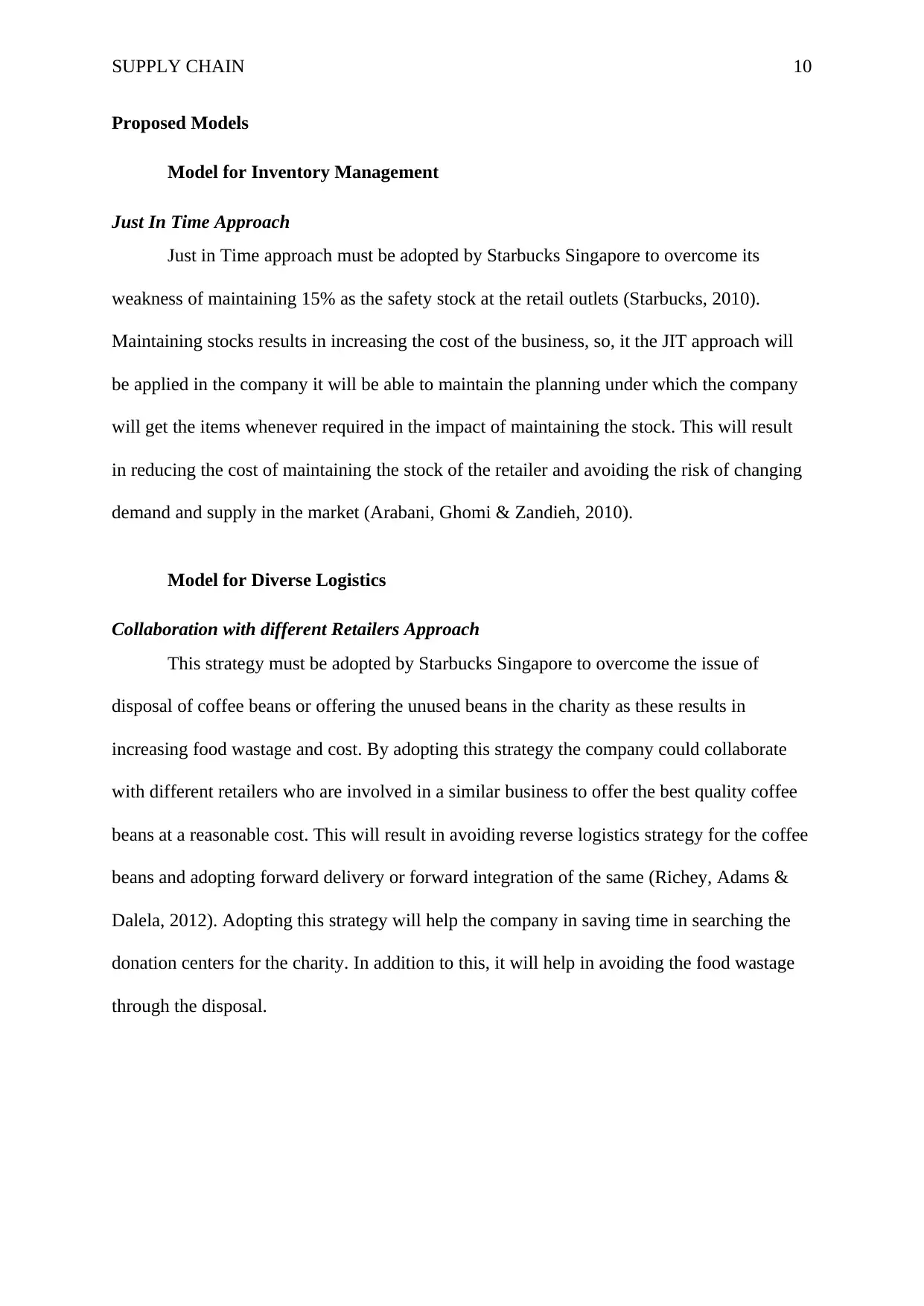
SUPPLY CHAIN 10
Proposed Models
Model for Inventory Management
Just In Time Approach
Just in Time approach must be adopted by Starbucks Singapore to overcome its
weakness of maintaining 15% as the safety stock at the retail outlets (Starbucks, 2010).
Maintaining stocks results in increasing the cost of the business, so, it the JIT approach will
be applied in the company it will be able to maintain the planning under which the company
will get the items whenever required in the impact of maintaining the stock. This will result
in reducing the cost of maintaining the stock of the retailer and avoiding the risk of changing
demand and supply in the market (Arabani, Ghomi & Zandieh, 2010).
Model for Diverse Logistics
Collaboration with different Retailers Approach
This strategy must be adopted by Starbucks Singapore to overcome the issue of
disposal of coffee beans or offering the unused beans in the charity as these results in
increasing food wastage and cost. By adopting this strategy the company could collaborate
with different retailers who are involved in a similar business to offer the best quality coffee
beans at a reasonable cost. This will result in avoiding reverse logistics strategy for the coffee
beans and adopting forward delivery or forward integration of the same (Richey, Adams &
Dalela, 2012). Adopting this strategy will help the company in saving time in searching the
donation centers for the charity. In addition to this, it will help in avoiding the food wastage
through the disposal.
Proposed Models
Model for Inventory Management
Just In Time Approach
Just in Time approach must be adopted by Starbucks Singapore to overcome its
weakness of maintaining 15% as the safety stock at the retail outlets (Starbucks, 2010).
Maintaining stocks results in increasing the cost of the business, so, it the JIT approach will
be applied in the company it will be able to maintain the planning under which the company
will get the items whenever required in the impact of maintaining the stock. This will result
in reducing the cost of maintaining the stock of the retailer and avoiding the risk of changing
demand and supply in the market (Arabani, Ghomi & Zandieh, 2010).
Model for Diverse Logistics
Collaboration with different Retailers Approach
This strategy must be adopted by Starbucks Singapore to overcome the issue of
disposal of coffee beans or offering the unused beans in the charity as these results in
increasing food wastage and cost. By adopting this strategy the company could collaborate
with different retailers who are involved in a similar business to offer the best quality coffee
beans at a reasonable cost. This will result in avoiding reverse logistics strategy for the coffee
beans and adopting forward delivery or forward integration of the same (Richey, Adams &
Dalela, 2012). Adopting this strategy will help the company in saving time in searching the
donation centers for the charity. In addition to this, it will help in avoiding the food wastage
through the disposal.
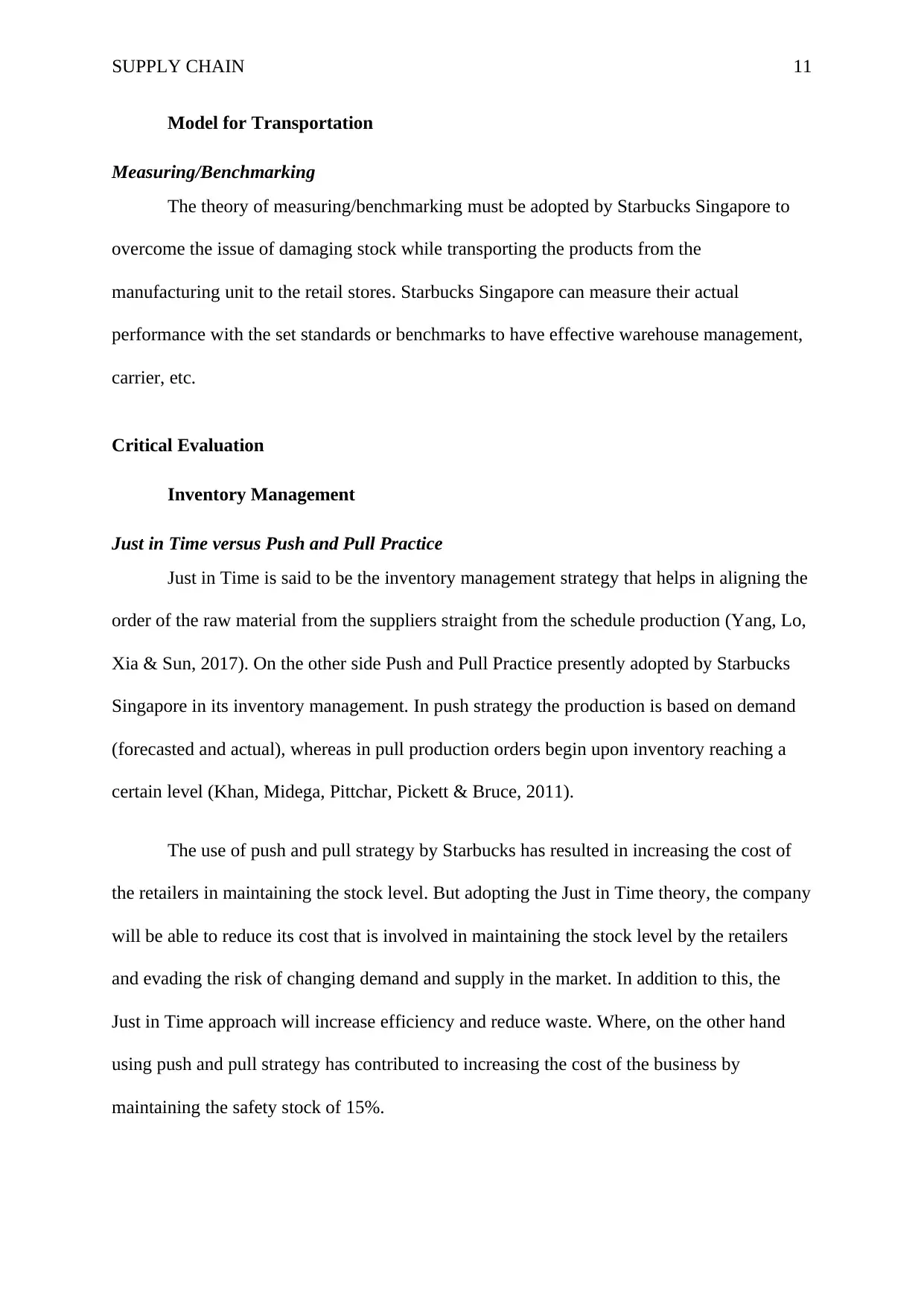
SUPPLY CHAIN 11
Model for Transportation
Measuring/Benchmarking
The theory of measuring/benchmarking must be adopted by Starbucks Singapore to
overcome the issue of damaging stock while transporting the products from the
manufacturing unit to the retail stores. Starbucks Singapore can measure their actual
performance with the set standards or benchmarks to have effective warehouse management,
carrier, etc.
Critical Evaluation
Inventory Management
Just in Time versus Push and Pull Practice
Just in Time is said to be the inventory management strategy that helps in aligning the
order of the raw material from the suppliers straight from the schedule production (Yang, Lo,
Xia & Sun, 2017). On the other side Push and Pull Practice presently adopted by Starbucks
Singapore in its inventory management. In push strategy the production is based on demand
(forecasted and actual), whereas in pull production orders begin upon inventory reaching a
certain level (Khan, Midega, Pittchar, Pickett & Bruce, 2011).
The use of push and pull strategy by Starbucks has resulted in increasing the cost of
the retailers in maintaining the stock level. But adopting the Just in Time theory, the company
will be able to reduce its cost that is involved in maintaining the stock level by the retailers
and evading the risk of changing demand and supply in the market. In addition to this, the
Just in Time approach will increase efficiency and reduce waste. Where, on the other hand
using push and pull strategy has contributed to increasing the cost of the business by
maintaining the safety stock of 15%.
Model for Transportation
Measuring/Benchmarking
The theory of measuring/benchmarking must be adopted by Starbucks Singapore to
overcome the issue of damaging stock while transporting the products from the
manufacturing unit to the retail stores. Starbucks Singapore can measure their actual
performance with the set standards or benchmarks to have effective warehouse management,
carrier, etc.
Critical Evaluation
Inventory Management
Just in Time versus Push and Pull Practice
Just in Time is said to be the inventory management strategy that helps in aligning the
order of the raw material from the suppliers straight from the schedule production (Yang, Lo,
Xia & Sun, 2017). On the other side Push and Pull Practice presently adopted by Starbucks
Singapore in its inventory management. In push strategy the production is based on demand
(forecasted and actual), whereas in pull production orders begin upon inventory reaching a
certain level (Khan, Midega, Pittchar, Pickett & Bruce, 2011).
The use of push and pull strategy by Starbucks has resulted in increasing the cost of
the retailers in maintaining the stock level. But adopting the Just in Time theory, the company
will be able to reduce its cost that is involved in maintaining the stock level by the retailers
and evading the risk of changing demand and supply in the market. In addition to this, the
Just in Time approach will increase efficiency and reduce waste. Where, on the other hand
using push and pull strategy has contributed to increasing the cost of the business by
maintaining the safety stock of 15%.
⊘ This is a preview!⊘
Do you want full access?
Subscribe today to unlock all pages.

Trusted by 1+ million students worldwide
1 out of 18
Related Documents
Your All-in-One AI-Powered Toolkit for Academic Success.
+13062052269
info@desklib.com
Available 24*7 on WhatsApp / Email
![[object Object]](/_next/static/media/star-bottom.7253800d.svg)
Unlock your academic potential
Copyright © 2020–2025 A2Z Services. All Rights Reserved. Developed and managed by ZUCOL.





